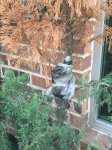zanna5910
Sapling
Hi all, I'm a lurker and new to bonsai, really having fun reading about it and starting out!
I did two air layers on some nursery j. chinesis about a week ago. I realize I'm late in the season, but my real issue is I used Chopped Sphagnum moss instead of the long strands of moss. Chalk that one up to learning and rookie mistakes I guess.
Do you guys think this will be okay and the junipers will root in this chopped medium or do I need to pull them apart and change out the medium to the long stranded moss?
Thanks all for your help!
I did two air layers on some nursery j. chinesis about a week ago. I realize I'm late in the season, but my real issue is I used Chopped Sphagnum moss instead of the long strands of moss. Chalk that one up to learning and rookie mistakes I guess.
Do you guys think this will be okay and the junipers will root in this chopped medium or do I need to pull them apart and change out the medium to the long stranded moss?
Thanks all for your help!



